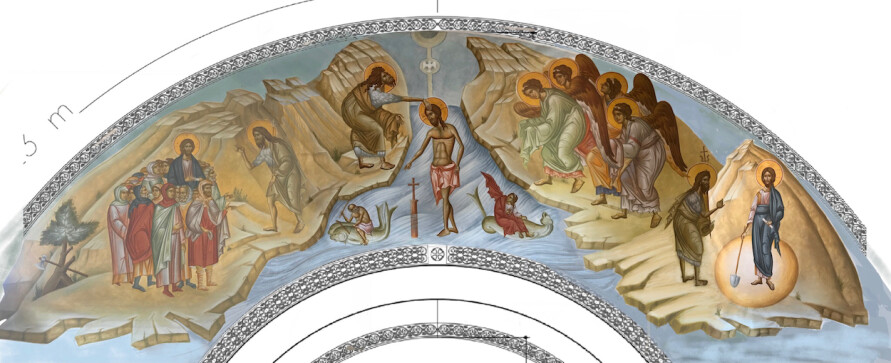THE IMAGE OF THE BAPTISM OF CHRIST: THE THEOPHANY

By His Grace Bishop Joachim of Amissos, PhD
Bishop Joachim of Amissos is an internationally recognized expert in Byzantine Iconography and is the Director of the Archbishop Iakovos Library at Hellenic College/Holy Cross.
As noted in previous Newsletters, Byzantine/Orthodox churches were provided with a number of images referred to as the Christological cycle, that is a cycle of images depicting scenes from the life of Christ and/or the Theotokos. These scenes often correspond to the major feasts of the liturgical year, thus linking the sacred images with liturgical celebrations of special feast-days and also to the Eucharist’s commemorative aspect of the entire saving events of the life of Christ.
One of the Christological scenes to be found in the Saint Nicholas Shrine at Ground Zero is that of the Baptism of Christ, or the Theophany, the manifestation of God, the liturgical commemoration of which is 6 January. Images of the Baptism appear as early as the 3rd century and the image was essentially standardized by the 6th century as seen on numerous objects of pilgrimage art originating from the Holy Land. The essential elements are found at the center of the image of the Baptism: Christ standing in the River Jordan, with Saint John the Baptist or Forerunner (the Prodromos), standing on the shore at the left, his right hand placed on the head of the Lord in the act of baptizing, while the Holy Spirit, in the form of a Dove emanating from the semicircular arc of Heaven, appears above His head (Matthew 3:13-17; Mark 1: 9-11; Mark 3: 21-22; John 1:32-34). As in some middle- and late-Byzantine examples, there is a cross placed in the middle of the River, a reference to the actual cross marking the traditional pilgrimage site of Christ’s Baptism in the Jordan. This detail further reinforces the pilgrimage nature of the Shrine, a sacred space for those seeking to worship during the Divine Services and to commemorate those who lost their lives at this site and to find solace in the promise of the Resurrection. The figures riding the marine creatures are personifications of the River Jordan, demonstrating the continuation of the classical tradition of personified rivers and seas into the realm of Christian art. They are shown turning away from the Lord and fleeing, visualizing the Psalm verses sung during the liturgical celebrations of Theophany: “The sea beheld and fled, Jordan tuned back” (113:3) and “What aileth thee, O sea, that thou fleddest? And thou Jordan, that thou didst turn back?” (113:5). Opposite Saint John, on the right bank, are the attendant Angles, bowing in worship at the appearance of Christ, God in the flesh, in the Jordan.
Our example has, to the left and right, additional narrative details related to the central event of the Baptism. Such enhanced depictions are found in various images of the Baptism from the late- and post-Byzantine period, such as in the 14th-century narthex mosaics of the church of the Chora in Constantinople and the Athonite churches of the Protaton and Chilandar. The two lateral subsidiary scenes depict Saint John’s witnessing of Christ. At the left, the Forerunner is announcing to the crowd of Pharisees and Levites, among whom stands Christ Himself, and proclaims, “I baptize with water: but there standeth one among you, whom ye know not…..(John 1:26). Behind the group appears a tree with the axe, an iconographic detail referencing Matthew 3:10 and Luke 3:9: “And now also the axe is laid unto the root of the trees…,” indicating that with the appearance of Christ, the Judgment is beginning.
At the right is seen the figure of the Baptist addressing Christ, who stands upon a circular disc with a winnowing fan in His right hand, visualizing the texts of Matthew 3:12 & Luke 3:17, which describe Christ purging the threshing floor and separating the wheat from the chaff, another metaphor for the Judgment.
The scene of the Baptism of Christ in the Shrine will be placed in the upper arched area of the north wall of the nave, directly opposite the scene of Christ’s Nativity in the corresponding location on the south wall. Historically, in the early Church, both events were commemorated together on 6 January and only later by the fourth century were they celebrated as two separate feast-days. The two images act in concert and antiphonally: both depict the appearance and revelation of the Incarnate God to the world.